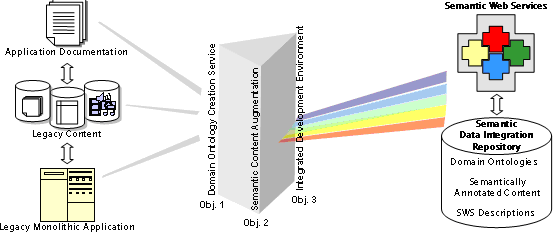GATE in TAO
Transitioning Applications to Ontologies
Summary
Semantic Web Services (SWS), and Service-Oriented Architectures (SOA) that host them, will make a significant contribution to the competitiveness of European ICT in the coming period. In particular, the TAO is about how existing "legacy" applications can migrate to open, semantics-based SOA.
We will create an open source infrastructure to aid transitioning of legacy applications to SOA, via ontologies and refactoring into SWS. This will enable a much larger group of companies to exploit semantics without having to re-implement their applications. The results will be validated in two high-profile case studies: a comprehensive open source platform (with thousands of users) and a data-intensive business process application (managing a multi-million business).
Now is the time to do this, because significant recent initiatives have built up strong foundations for practical semantic SOA. They have shown how new systems can profitably deploy semantics as a lingua franca for modeling the points of contact between software components at a higher level than previous technology. Now we need to show how existing applications can profit from semantics based architectures. TAO will ease the adaptation of the applications to these SOA through semantic web-service bootstrapping ? an innovative methodology, based on state-of-the-art ontology learning and semantic data integration.
TAO is funded as a Specific Targeted Research Project under European Commission 6th FP with a budget around 3M euros. It starts from March 2006 and runs for 3 years. TAO is coordinated by Dr. Kalina Bontcheva, University of Sheffield, UK.
Contact: Kalina Bontcheva (PI).
Project Objectives:
The project's goal is to show how existing 'legacy' applications can migrate to open, semantic-based Service-Oriented Architectures at acceptable development cost. The corresponding objectives are shown schematically on the figure below and are as follows:
- SWS bootstrapping via semi-automatic acquisition of domain ontologies from legacy DB schemata, application documentation, and API-level code and comments (Objective 1 in the figure below);
- augmentation and integration of legacy content (databases and documents used by applications) relative to the domain ontologies to create semantic repositories with ontology based information access (Objective 2 in the figure below);
- Transitioning Methodology and Infrastructure (Objective 3 in the figure below): support the developer with a user-friendly infrastructure for the transitioning of existing application into semantic SOAs. A SWS bootstrapping methodology with detailed examples from an open-source reference application will be provided to facilitate take-up.

Our Role
The main role of the GATE team will be on automatic methods for content augmentation and integration (Objective 2). This problem is typically approached with Human Language Technology (HLT) methods, and more specifically, Information Extraction. IE deals with automatically deriving the semantics of multimodal content. HLT is being used for automating knowledge acquisition and metadata creation from textual content as part of the SEKT, Esperonto and other related projects.
In TAO, we will go beyond the state of the art by enhancing these methods to support metadata creation and augmentation from diverse content types relating to legacy applications (e.g., software documentation, screenshot images, training videos). The components implemented will be made part of GATE ? one of the most mature and popular open-source language technology platforms, which already provides a large number of tools in many languages.
In addition, GATE will become the publicly available reference showcase of a refactored ontology- and service-based system (as one of the case studies in the project). There are three tasks to be completed to transform GATE into a semantic SOA:
- the elicitation of an ontology to represent the concepts fundamental in the GATE architecture
- alongside this, the exposure of semantic-based access to the GATE document base;
- finally, uniting the results of these two processes, the description of this functionality in semantic terms.
The result will be to validate the TAO methodology for these tasks and the support provided by the graphical user-interface of the TAO infrastructure. The resulting ontology- and service-based system will be made available as a reference TAO case study.
Funding:
- Project Web page: www.tao-project.eu
- Project Reference: IST-2004-026460
- Project Acronym: TAO
- Project Name: Transitioning Applications to Ontologies
- Action line: IST-2004-2.4.7
- Total cost: 4,246,696 Euros
- Commission Funding: 2,824,950 Euros
- Project Duration: 2006-03-01 to 2009-02-28
- Project Fact Sheet
- TAO poster





